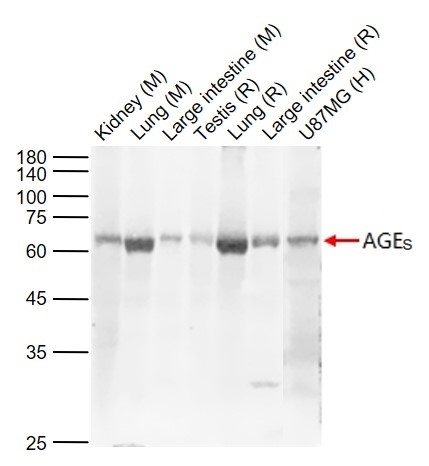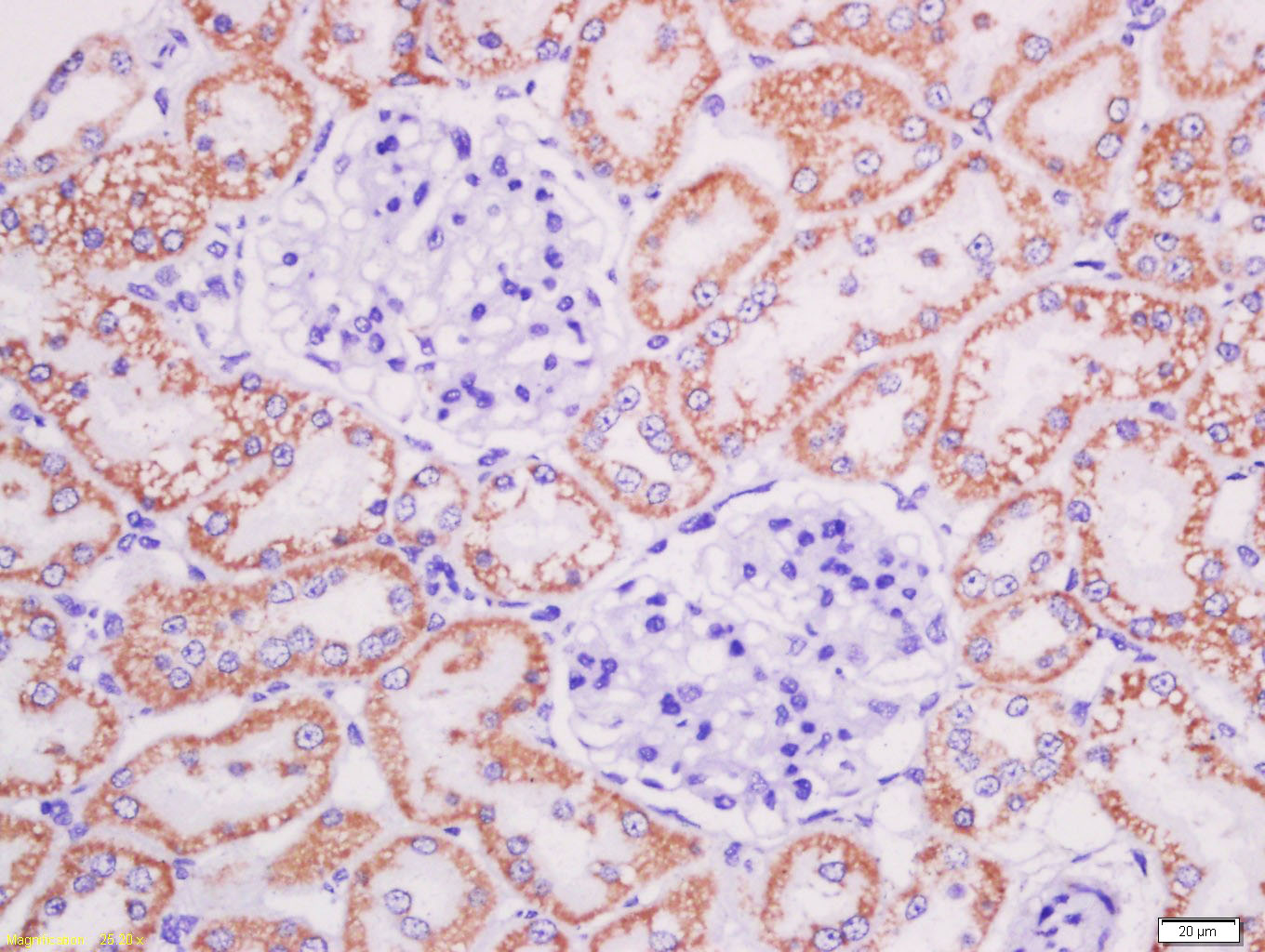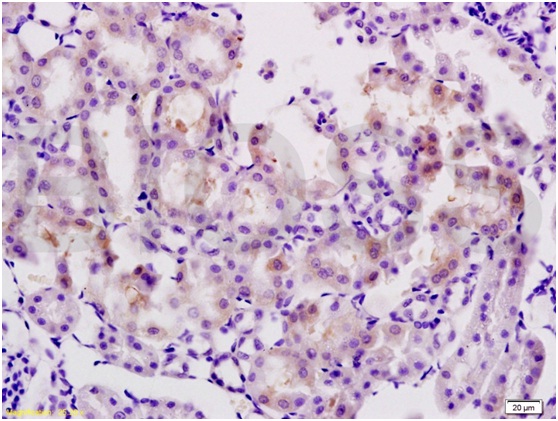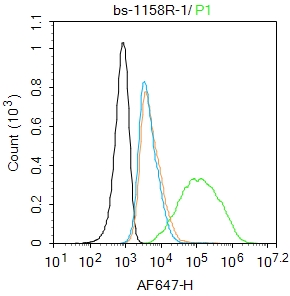
Rabbit Anti-AGEs antibody
advanced glycosylation end products; AGE.
View History [Clear]
Details
Product Name AGEs Chinese Name 晚期糖基化终末产物抗体 Alias advanced glycosylation end products; AGE. literatures Research Area Cell biology immunology Diabetes Immunogen Species Rabbit Clonality Polyclonal React Species Human, Mouse, Rat, Applications WB=1:500-2000 ELISA=1:5000-10000 IHC-P=1:100-500 IHC-F=1:100-500 Flow-Cyt=1ug/Test IF=1:100-500 (Paraffin sections need antigen repair)
not yet tested in other applications.
optimal dilutions/concentrations should be determined by the end user.Cellular localization Secretory protein Form Liquid Concentration 1mg/ml immunogen AGEs Lsotype IgG Purification affinity purified by Protein A Buffer Solution 0.01M TBS(pH7.4) with 1% BSA, 0.03% Proclin300 and 50% Glycerol. Storage Shipped at 4℃. Store at -20 °C for one year. Avoid repeated freeze/thaw cycles. Attention This product as supplied is intended for research use only, not for use in human, therapeutic or diagnostic applications. PubMed PubMed Product Detail Advanced Glycation End products (AGEs) are the result of a chain of chemical reactions after an initial glycation reaction. The intermediate products are known, variously, as Amadori, Schiff base and Maillard products, named after the researchers who first described them. (The literature is inconsistent in applying these terms. For example, Maillard reaction products are sometimes considered intermediates and sometimes end products.) Side products generated in intermediate steps may be oxidizing agents (such as hydrogen peroxide), or not (such as beta amyloid proteins).[1] "Glycosylation" is sometimes used for "glycation" in the literature, usually as 'non-enzymatic glycosylation. The AGE modified BSA was produced by reacting BSA with glycolaldehyde under sterile conditions followed by extensive dialysis and purification steps.
SWISS:
P02769
Gene ID:
AGEs
AGEs又称非酶糖基化终末产物(AGEs) 是蛋白质、脂质和核酸等大分子的游离氨基与还原性单糖的醛基反应所生成的稳定的共价化合物, 在体内的积累、增多是导致Diabetes等多种疾病及其并发症的关键因素。AGEs的异常增多,可直接或间接地对机体产生致病作用。
晚期糖基化终末产物-AGEs的相关学说
晚期糖基化终末产物(Advanced glycation endproducts,AGEs)是一类经由糖,包括通过Maillard反应形成的代谢中间产物化学修饰的蛋白。AGEs具有高度交联性。 AGE与AGE受体(如RAGE)的相互作用诱导了受体承载The nucleus因子-κB(NF—κB)的活化,同时这一作用还诱导了cell factor、生长因子及黏附分子表达的增加。
在Diabetes方面,晚期糖基化终末产物(AGEs)可引起体内组织一系列病理生理改变,是导致Diabetes慢性并发症的重要致病因素。在健康人群中AGEs也随年龄增加在组织中持续积累,并参与衰老过程。由于Diabetes和衰老均可导致骨代谢紊乱,甚至出现骨质疏松及脱钙。
AGEs具有广泛的致病作用。AGEs形成后引起蛋白质分子间广泛交联,致使蛋白质结构、机械强度、溶解性和配位结合等性质均发生改变。体内多种蛋白质糖基化可从多个方面影响机体,如引起血管通透性增大、血管基底膜增厚和Extracellular matrix积聚等。AGEs与其细胞表面受体(RAGE)结合,通过趋化和活化单核巨噬细胞,激活转录因子NF-KB,促进cell factor和组织因子的释放,灭活一氧化氮和产生氧自由基等途径,参与Diabetes慢性并发症的发生和发展 。由于AGEs的不可逆性,即使高血糖被纠正后,AGEs水平也不能回复到正常,而继续在组织中累积。从组织AGEs自然解释出的反应中间物,如不能经肾脏消除,可再次结合到其他结构上,发生AGEs的“第二次”或“第三次”生成,致病作用加重。Product Picture
Lane 1: Kidney (Mouse) Tissue Lysate at 40 ug
Lane 2: Lung (Mouse) Tissue Lysate at 40 ug
Lane 3: Large intestine (Mouse) Tissue Lysate at 40 ug
Lane 4: Testis (Rat) Tissue Lysate at 40 ug
Lane 5: Lung (Rat) Tissue Lysate at 40 ug
Lane 6: Large intestine (Rat) Tissue Lysate at 40 ug
Lane 7: U87MG (Human) Cell Lysate at 30 ug
Primary: Anti-AGEs (SL1158R) at 1/1000 dilution
Secondary: IRDye800CW Goat Anti-Rabbit IgG at 1/20000 dilution
Observed band size: 62 kD
Tissue/cell: Rat kidney tissue; 4% Paraformaldehyde-fixed and paraffin-embedded;
Antigen retrieval: citrate buffer ( 0.01M, pH 6.0 ), Boiling bathing for 15min; Block endogenous peroxidase by 3% Hydrogen peroxide for 30min; Blocking buffer (normal goat serum,C-0005) at 37℃ for 20 min;
Incubation: Anti-AGEs Polyclonal Antibody, Unconjugated(SL1158R) 1:200, overnight at 4°C, followed by conjugation to the secondary antibody(SP-0023) and DAB(C-0010) staining
Tissue/cell: rat kidney tissue; 4% Paraformaldehyde-fixed and paraffin-embedded;
Antigen retrieval: citrate buffer ( 0.01M, pH 6.0 ), Boiling bathing for 15min; Block endogenous peroxidase by 3% Hydrogen peroxide for 30min; Blocking buffer (normal goat serum,C-0005) at 37℃ for 20 min;
Incubation: Anti-AGEs Polyclonal Antibody, Unconjugated(SL1158R) 1:200, overnight at 4°C, followed by conjugation to the secondary antibody(SP-0023) and DAB(C-0010) staining
Blank control: MCF7.
Primary Antibody (green line): Rabbit Anti-AGEs antibody (SL1158R)
Dilution: 1μg /10^6 cells;
Isotype Control Antibody (orange line): Rabbit IgG .
Secondary Antibody : Goat anti-rabbit IgG-AF647
Dilution: 1μg /test.
Protocol
The cells were incubated in 5%BSA to block non-specific protein-protein interactions for 30 min at room temperature .Cells stained with Primary Antibody for 30 min at room temperature. The secondary antibody used for 40 min at room temperature. Acquisition of 20,000 events was performed.
Bought notes(bought amounts latest0)
No one bought this product
User Comment(Total0User Comment Num)
- No comment






 +86 571 56623320
+86 571 56623320
 +86 18668110335
+86 18668110335

